Advertisements
Advertisements
प्रश्न
In Figure, Vo is the potential barrier across a p-n junction, when no battery is connected across the junction ______.
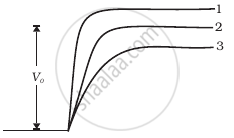
विकल्प
1 and 3 both correspond to forward bias of junction.
3 corresponds to forward bias of junction and 1 corresponds to reverse bias of junction.
1 corresponds to forward bias and 3 corresponds to reverse bias of junction.
3 and 1 both correspond to reverse bias of junction.
उत्तर
In Figure, Vo is the potential barrier across a p-n junction, when no battery is connected across the junction 3 corresponds to forward bias of junction and 1 corresponds to reverse bias of junction.
Explanation:
P-N Junction Diode: When a P-type semiconductor is suitably joined to an N-type semiconductor, then the resulting arrangement is called a P-N junction or P-N junction diode.

(1) Depletion region: On account of the difference in concentration of charge carrier in the two sections of the P-N junction, the electrons from N-region diffuse through the junction into P-region and the hole from the P region diffuses into N-region.
Due to diffusion, the neutrality of both N and P-type semiconductor is disturbed and a layer of negatively charged ions appear near the junction in the P-crystal and a layer of positive ions appears near the junction in N-crystal. This layer is called the depletion layer.
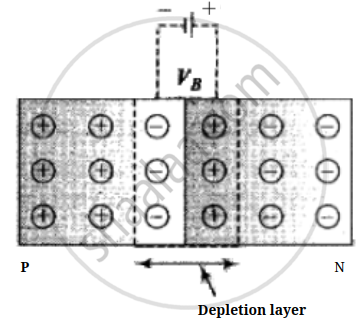
- The thickness of the depletion layer is 1 micron = 10–6 m.
- Width of the depletion layer ∝ `1/"Dopping"`
- Depletion is directly proportional to temperature.
- The P-N junction diode is equivalent to the capacitor in which the depletion layer acts as a dielectric.
(2) Potential barrier: The potential difference created across the P-N junction due to the diffusion of electrons and holes is called the potential barrier.
For Ge, VB = 0.3 V and for silicon VB = 0. 7 V
On average the potential barrier in a P-N junction is – 0.5 V and the width of the depletion region = 10–6m.
So the barrier electric field `E = V/d = 0.5/10^-6 = 5 xx 10^5` V/m
The height of the potential barrier is decreased when the p-n junction is forward biased, it opposes the potential barrier junction when the p-n junction is reverse biased and it supports the potential barrier junction, resulting increase in the potential barrier across the junction.
APPEARS IN
संबंधित प्रश्न
(i) Explain with the help of a diagram the formation of depletion region and barrier potential in a pn junction.
Explain the working of P-N junction diode in forward and reverse biased mode.
When a forward bias is applied to a p-n junction, it ______.
A triode value operates at Vp = 225 V and Vg = −0.5 V.
The plate current remains unchanged if the plate voltage is increased to 250 V and the grid voltage is decreased to −2.5 V. Calculate the amplification factor.
With reference to a semiconductor diode, what is meant by:
(i) Forward bias
(ii) Reverse bias
(iii) Depletion region
Of the diodes shown in the following diagrams, which one is reverse biased?
In the depletion region of a diode ______.
- there are no mobile charges.
- equal number of holes and electrons exist, making the region neutral.
- recombination of holes and electrons has taken place.
- immobile charged ions exist.
If each diode in figure has a forward bias resistance of 25 Ω and infinite resistance in reverse bias, what will be the values of the current I1, I2, I3 and I4?
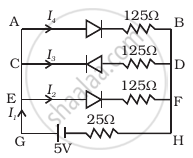
Describe briefly the following term:
minority carrier injection in forward biasing.
Read the following paragraph and answer the questions that follow.
| A semiconductor diode is basically a pn junction with metallic contacts provided at the ends for the application of an external voltage. It is a two-terminal device. When an external voltage is applied across a semiconductor diode such that the p-side is connected to the positive terminal of the battery and the n-side to the negative terminal, it is said to be forward-biased. When an external voltage is applied across the diode such that the n-side is positive and the p-side is negative, it is said to be reverse-biased. An ideal diode is one whose resistance in forward biasing is zero and the resistance is infinite in reverse biasing. When the diode is forward biased, it is found that beyond forward voltage called knee voltage, the conductivity is very high. When the biasing voltage is more than the knee voltage the potential barrier is overcome and the current increases rapidly with an increase in forward voltage. When the diode is reverse biased, the reverse bias voltage produces a very small current of about a few microamperes which almost remains constant with bias. This small current is a reverse saturation current. |
- In the given figure, a diode D is connected to an external resistance R = 100 Ω and an emf of 3.5 V. If the barrier potential developed across the diode is 0.5 V, the current in the circuit will be:

(a) 40 mA
(b) 20 mA
(c) 35 mA
(d) 30 mA - In which of the following figures, the pn diode is reverse biased?
(a)
(b)
(c)
(d)
- Based on the V-I characteristics of the diode, we can classify the diode as:
(a) bilateral device
(b) ohmic device
(c) non-ohmic device
(d) passive element
OR
Two identical PN junctions can be connected in series by three different methods as shown in the figure. If the potential difference in the junctions is the same, then the correct connections will be:
(a) in the circuits (1) and (2)
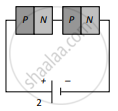
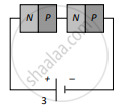
(b) in the circuits (2) and (3)
(c) in the circuits (1) and (3)
(d) only in the circuit (1) 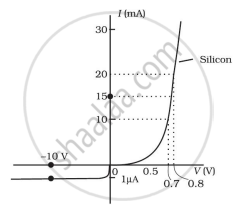
The V-I characteristic of a diode is shown in the figure. The ratio of the resistance of the diode at I = 15 mA to the resistance at V = -10 V is
(a) 100
(b) 106
(c) 10
(d) 10-6
